Refer to CBSE Class 10 Science The Human Eye and the Colourful World MCQs Set D provided below available for download in Pdf. The MCQ Questions for Class 10 Science with answers are aligned as per the latest syllabus and exam pattern suggested by CBSE, NCERT and KVS. Chapter 10 The Human Eye and the Colourful World Class 10 MCQ are an important part of exams for Class 10 Science and if practiced properly can help you to improve your understanding and get higher marks. Refer to more Chapter-wise MCQs for CBSE Class 10 Science and also download more latest study material for all subjects
MCQ for Class 10 Science Chapter 10 The Human Eye and the Colourful World
Class 10 Science students should refer to the following multiple-choice questions with answers for Chapter 10 The Human Eye and the Colourful World in Class 10.
Chapter 10 The Human Eye and the Colourful World MCQ Questions Class 10 Science with Answers
Question: Two identical prism PQR and P’Q’R’ are given. White light is passed through PQR as shown below.
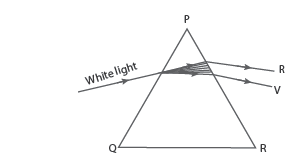
Which of the following position of P’Q’R’ will again yield white light?
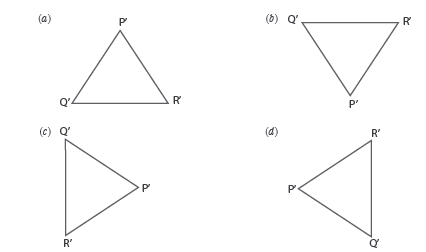
Answer: c
Question: Sunlight is a mixture of __ visible colours
a) 5
b) 6
c) 7
d) None
Answer: c
Question: When a ray passes through a prism __________.
a) It goes undeviated
b) It remains parallel to base
c) It bends towards the base
d) None
Answer: c
Question: The various angles are labeled in the image. Which angle shows the angle of incidence and angle of refraction, respectively?
a) A and D
b) C and F
c) D and F
d) B and E
Answer: b
Question: The coloured light having the maximum speed in glass prism is:
a) blue
b) green
c) violet
d) yellow
Answer: d
Question: A student sitting on the last bench in the class cannot read the writing on the blackboard clearly but he can read the book lying on his desk clearly. Which of the following statement is correct about the student?
a) The near point of his eyes has receded away.
b) The near point of his eyes has come closer to him.
c) The far point of his eyes has receded away.
d) The far point of his eyes has come closer to him.
Answer: d
Question: Having two eyes gives a person:
a) deeper field of view
b) coloured field of view
c) rear field of view
d) wider field of view
Answer: d
Question: The defect of vision in which the eye-lens of a person gets progressively cloudy resulting in blurred vision is called:
a) myopia
b) presbyopia
c) colourblindness
d) cataract
Answer: d
Question: Which image shows the deviation of light in a prism?
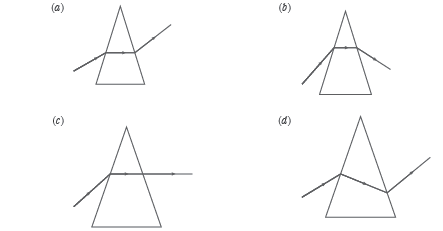
Answer: b
Question: With both eyes open, a person’s field of view is about:
a) 90°
b) 150°
c) 180°
d) 360°
Answer: c
Question: Which of the following coloured light has the least speed in glass prism?
a) violet
b) yellow
c) red
d) green
Answer: a
Question: A beam of white light is shone onto a glass prism. The light cannot be:
a) deviated
b) dispersed
c) focused
d) refracted
Answer: c
Question: The animal which does not have eyes that look sideways is:
a) Horse
b) Chicken
c) Lion
d) Fish
Answer: c
Question: The colour of white light which is deviated the maximum on passing through the glass prism is:
a) blue
b) indigo
c) red
d) orange
Answer: b
Question: A person finds difficulty in seeing nearby objects clearly. His vision can be corrected by using spectacles containing:
a) converging lenses
b) diverging lenses
c) prismatic lenses
d) chromatic lenses
Answer: a
Question: The day is longer on the earth by about 4 minutes because:
a) the earth is round in shape
b) the earth rotates on its axis
c) the earth has atmosphere
d) the earth revolves around the sun
Answer: c
Question: A person cannot see distant objects clearly. His vision can be corrected by using the spectacles containing:
a) concave lenses
b) plane lenses
c) contact lenses
d) convex lenses
Answer: a
Question: A ray of light is incident on one face of the prism, as shown.

How will the ray of light disperse in the prism?
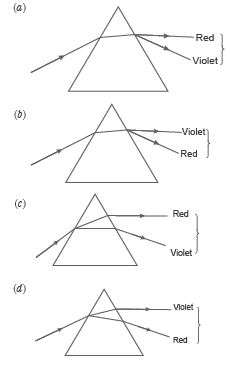
Answer: c
Question: The splitting up of white light into seven colours on passing through a glass prism is called:
a) refraction
b) deflection
c) dispersion
d) scattering
Answer: c
Question: The twinkling of stars is due to atmospheric:
a) reflection of light
b) dispersion of light
c) interference of light
d) refraction of light
Answer: d
Question: As light from a far off star comes down towards the earth:
a) it bends away from the normal
b) it bends towards the normal
c) it does not bend at all
d) it is reflected back
Answer: b
Question: We can see the sun before the actual sunrise by about:
a) 5 minutes
b) 2 minutes
c) 2 hours
d) 20 minutes
Answer: b
Question: A person got his eyes tested. The optician’s prescription for the spectacles reads:
Left eye: –3.00 D
Right eye: –3.50 D
The person is having a defect of vision called:
a) presbyopia
b) myopia
c) astigmatism
d) hypermetropia
Answer: b
Question: Which of the following colour of white light is least deviated by the prism?
a) green
b) violet
c) indigo
d) yellow
Answer: d
Question: A man driving a car can read a distant road sign clearly but finds difficulty in reading the odometer on the dashboard of the car. Which of the following statement is correct about this man?
a) The near point of his eyes has receded away.
b) The near point of his eyes has come closer to him.
c) The far point of his eyes has receded away.
d) The far point of his eyes has come closer to him.
Answer: a
Question: The atmospheric refraction of light causes the twinkling of:
a) Planets only
b) Stars only
c) Planets and stars
d) Stars and satellites
Answer: b
Question: After testing the eyes of a child, the optician has prescribed the following lenses for his spectacles:
Left eye: +2.00 D
Right eye: +2.25 D
The child is suffering from the defect of vision called:
a) Short-sightedness
b) Long-sightedness
c) Cataract
d) Presbyopia
Answer: b
Question: The image shows the dispersion of the white light in the prism.
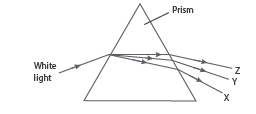
What will be the colours of the X, Y and Z? We can see a rainbow on a sunny day when y
a) X: green; Y: violet; Z: red
b) X: violet; Y: green; Z: red
c) X: red; Y: violet; Z: green
d) X: red; Y: green; Z: violet
Answer: b
Question: The image shows a light ray incident on a glass prism.
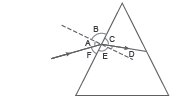
Answer: a
Question: Your friend can read a book perfectly well but cannot read the writing on blackboard unless she sits on the front row in class.
(a) Is she short-sighted or long-sighted?
(b) What
type of lenses—converging or diverging—would an optician prescribe for her?
Answer:
(a) Short-sighted
(b) Diverging lenses
Question: Name the defect of vision in a person:
(a) whose near point is more than 25 cm away.
(b) whose far point is less than infinity.
Answer:
(a) Hypermetropia
(b) Myopia
Question: Out of animals of prey and predators, which have their eyes:
(i) at the front of their head?
(ii) on the opposite sides of their head?
Answer: (i) Predators
(ii) Animals of prey
Question: Name the part of the eye:
(a) which controls the amount of light entering the eye.
(b) on which the image is formed.
(c) which changes the focal length of eye-lens.
Answer:
(a) Iris
(b) Retina
(c) Ciliary muscles
Question: Give the scientific names of the following parts of the eye:
(a) carries signals from an eye to the brain.
(b) muscles which change the shape of the eye-lens.
(c) a hole in the middle of the iris.
(d) a clear window at the front of the eye.
(e) changes shape to focus a picture on the retina.
Answer:
(a) Optic nerve
(b) Ciliary muscles
(c) Pupil
(d) Cornea
(e) Eye-lens
Fill in the following blanks with suitable words :
Question: Having two eyes enables us to judge……………..more accurately.
Answer: distances
Question: As light rays pass from air into a glass prism, are they refracted towards or away from the normal ?
Answer: Towards the normal
Question: Which phenomenon makes us see the sun :
(b) a few minutes after actual sunset ?
Answer: atmospheric refraction of sunlight
Question: Atmospheric refraction causes advance sunrise and delayed sunset. By how much time is :
(b) sunset delayed ?
Answer: (b) About 2 minutes
Question: Which of the two is scattered more easily : light of shorter wavelengths or light of longer wavelengths ?
Answer: Light of shorter wavelength
Following questions consists of two statements – Assertion (A) and Reason (R). Answer these questions selecting the appropriate option given below:
A. Both assertion and reason are true, and reason is the correct explanation of assertion.
B. Both assertion and reason are true, but reason is not the correct explanation of assertion.
C. Assertion is true but reason is false.
D. Assertion is false and reason is true.
Question: Assertion(A): A prism can split the incident white light into bands of different colours.
Reason(R): The different colours of light bend through different angles with respect to the incident rays.
Answer: a
Question: Assertion(A): In case of rainbow, light at the inner surface of the water drop gets internally reflected.
Reason(R): The angle between the refracted ray and normal to the drop surface is greater than the critical angle.
Answer: a
Question: Assertion(A): The light of violet colour deviates the most and the light of red colour the least, while passing through a prism.
Reason(R): For a prism material, refractive index is highest for red light and lowest for the violet light.
Answer: b
Question: Assertion: The colour of the scattered light does not depend on the size of the scattering particles.
Re Reason: Red light is used as a danger signal because it can travel longer distances through rain and fog.
Answer: c
Question: Assertion: The sky appears dark in outer space..
Reason : Scattering does not occur in outer space as there is no atmosphere
Answer: a
Question: Assertion: Rainbow is an example of the dispersion of sunlight by the water droplets.
Reason: Light of shorter wavelength is scattered much more than light of larger wavelength.
Answer: b
MCQs for Chapter 10 The Human Eye and the Colourful World Science Class 10
Expert teachers of studiestoday have referred to NCERT book for Class 10 Science to develop the Science Class 10 MCQs. If you download MCQs with answers for the above chapter you will get higher and better marks in Class 10 test and exams in the current year as you will be able to have stronger understanding of all concepts. Daily Multiple Choice Questions practice of Science will help students to have stronger understanding of all concepts and also make them expert on all critical topics. After solving the questions given in the MCQs which have been developed as per latest books also refer to the NCERT solutions for Class 10 Science. We have also provided lot of MCQ questions for Class 10 Science so that you can solve questions relating to all topics given in each chapter. After solving these you should also refer to Class 10 Science MCQ Test for the same chapter.
You can download the CBSE MCQs for Class 10 Science Chapter 10 The Human Eye and the Colourful World for latest session from StudiesToday.com
Yes, the MCQs issued by CBSE for Class 10 Science Chapter 10 The Human Eye and the Colourful World have been made available here for latest academic session
You can find CBSE Class 10 Science Chapter 10 The Human Eye and the Colourful World MCQs on educational websites like studiestoday.com, online tutoring platforms, and in sample question papers provided on this website.
To prepare for Chapter 10 The Human Eye and the Colourful World MCQs, refer to the concepts links provided by our teachers and download sample papers for free.
Yes, there are many online resources that we have provided on studiestoday.com available such as practice worksheets, question papers, and online tests for learning MCQs for Class 10 Science Chapter 10 The Human Eye and the Colourful World

